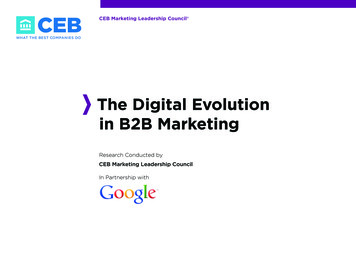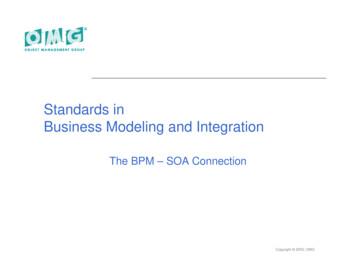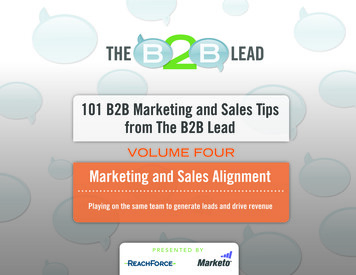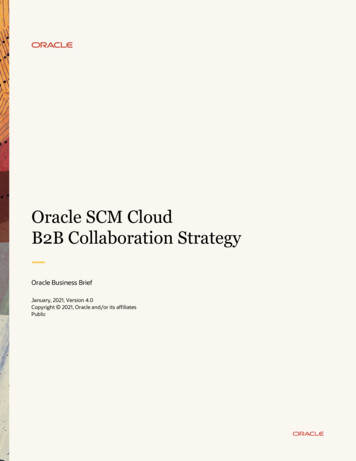
Transcription
CeB Marketing leadership Council The Digital evolutionin B2B MarketingResearch Conducted byCEB Marketing Leadership Councilin Partnership with
CEB Marketing Leadership Council Content Publishing SolutionsExecutive DirectorMolly MaycockDesign SpecialistTim BrownManaging DirectorPatrick SpennerDesign AssociateNicole DanielsConsultantsRobert HamsharShelley WestEditorNidhi Vikram ChoudhuryConfidentiality and Intellectual PropertyThese materials have been prepared by CEB for the exclusive and individual use of our member companies. These materialscontain valuable confidential and proprietary information belonging to CEB and they may not be shared with any thirdparty (including independent contractors and consultants) without the prior approval of CEB. CEB retains any and allintellectual property rights in these materials and requires retention of the copyright mark on all pages reproduced.Legal CaveatCEB is not able to guarantee the accuracy of the information or analysis contained in these materials. Furthermore, CEB isnot engaged in rendering legal, accounting, or any other professional services. CEB specifically disclaims liability for anydamages, claims or losses that may arise from a) any errors or omissions in these materials, whether caused by CEB or itssources, or b) reliance upon any recommendation made by CEB.The Digital Evolution in B2B Marketing 2012 The Corporate Executive Board Company.All Rights Reserved. MLC5230113SYNwww.executiveboard.com
About This ResearchResearch ObjectivesThis research aims to meet the following three objectives: Identify shared challenges faced by marketing leaders in large business-to-business (B2B) organizations in structuring a digitalmarketing capability and supporting a content-led marketing approach.Synthesize frameworks for understanding and resolving those challenges based on demonstrated practices and expert analysis.Provide meaningful recommendations and case examples to help B2B marketing leaders advance against their challenges.Research InputThis research is based on a combination four key components: Quantitative benchmark research and analysis from CEB Marketing Leadership Council and CEB Sales Leadership Council intoB2B marketing and sales practicesInsight from CEB Marketing Leadership Council, CEB Sales Leadership Council, and CEB CIO Leadership Council and fromsubject matter experts at GoogleStructured interviews with marketing leaders at B2B organizationsInformation from and interviews with numerous vendors, consultants, agencies, and research organizations operating in thedigital marketing spaceScope LimitationsThis research addresses specific research questions considered to be of greatest shared concern to professionals who oversee digitalmarketing and demand generation programs at large B2B organizations. As a result, this research may not satisfy the informationneeds of all readers.CEBCEB is the leading member-based advisory company. By combining the best practices of thousands of member companies with ouradvanced research methodologies and human capital analytics, we equip senior leaders and their teams with insight and actionablesolutions to transform operations.This distinctive approach, pioneered by CEB, enables executives to harness peer perspectives and tap into breakthrough innovationwithout costly consulting or reinvention. The CEB member network includes more than 16,000 executives and the majority of topcompanies globally.For more information visit www.executiveboard.com.The Digital Evolution in B2B Marketing 2012 The Corporate Executive Board Company.All Rights Reserved. MLC5230113SYNwww.executiveboard.com
A Note of ThanksAs with all CEB studies, this research would not have been possible without the generosity of several individuals who were willing toshare their insight, experiences, and practices. In particular, we would like to express our gratitude to the following individuals:Todd Forsythe (EMC Corporation)Melissa Madian (Eloqua)Ethan Hayes (Gyro)Nick Panayi (CSC Corporation)David Deans (Cisco Systems)Andy Markowitz (General Electric)Ken Demma (SAP Corporation)Jeff Bowman (Caterpillar)Denise Beckman (IBM Corporation)Brian Reed (Boxtone)Pat LaPointe (Market Share Partners)Nancy Kay (TELUS)Duane Schulz (Xerox)The Digital Evolution in B2B Marketing 2012 The Corporate Executive Board Company.All Rights Reserved. MLC5230113SYNwww.executiveboard.com
Table of ContentsPrologue: The Current State of Practice 1Chapter I: Increase Impact Through Integration 7Chapter II: Focus Content Strategy and Activation 17Chapter III: Strengthen Multichannel Analytics 32The Digital Evolution in B2B Marketing 2012 The Corporate Executive Board Company.All Rights Reserved. MLC5230113SYNwww.executiveboard.com
CEB Marketing Leadership Council PrologueThe Current State of PracticeThe Digital Evolution in B2B Marketing 2012 The Corporate Executive Board Company.All Rights Reserved. MLC5230113SYNwww.executiveboard.com1
Prologue: The Current State of PracticeThe Rising Importance of DigitalOn average, customers progressnearly 60% of the way through thepurchase decision-making processbefore engaging a sales rep.Potential customers are readily turning to their personal networks and publicly available information—increasingly via digital and socialmedia channels—to self-diagnose their problems and form opinions about solutions.To understand the scope of this issue in the B2B context, CEB Marketing Leadership Council surveyed more than 1,500 customercontacts (decision makers and influencers in a recent major business purchase) for 22 large B2B organizations (spanning all majorNAICS categories and 10 industries). In a striking finding, the survey revealed that the average customer had completed more than onehalf of the purchase decision-making process prior to engaging a supplier sales rep directly (Figure 1). At the upper limit, that numberran as high as 70% (Figure 2).The fundamental implication is clear: companies that fail to “show up strong” in this context are underserving potential customers andat risk of losing mindshare and, ultimately, sales opportunities.Figure 1: Degree of Progress Through thePurchase Process Before Engaging Sales2Customer AverageDistribution of Supplier AveragesFrequency of ResponseCustomers are choosing to delaycommercial conversations with suppliers.57%CompleteCustomer DueDiligence BeginsFigure 2: Degree of Progress Through thePurchase Process Before Engaging SalesCustomer’s FirstSerious Engagementwith Salesn 1,500.Purchase8453200100% 45% 45– 51– 56– 61– 66– 70%50% 55% 60% 65% 70%Customer DuePurchaseDiligence BeginsPoint in Purchase Process0%n customers from 22 suppliers.Source: CEB, Customer Purchase Research Survey, 2011.The Digital Evolution in B2B Marketing 2012 The Corporate Executive Board Company.All Rights Reserved. MLC5230113SYNwww.executiveboard.com
Prologue: The Current State of PracticeThe Current State of PracticeMost organizations have takensteps to deepen and consolidatedigital expertise, resulting in newmanagerial challenges.Budget benchmarks and opinion polls convincingly show that B2B marketers across industries are investing in building out digitalinfrastructure and capabilities, although the trend has been less pronounced in slower-moving industries. Digital spend amongengineering, applied technology, telecommunications, and professional services companies often exceeds 15% of total budget, with somelarge organizations claiming to invest more than one-half of marketing budget in digital programs.Although some of the marketers we interviewed remain in an experimentation phase, hindered by organizational disinterest in digitalmedia, most organizations have progressed toward consolidating and deepening expertise on key digital tactics and responsibilities.We consider such “consolidators” to represent the mid-spectrum of practice, in which several performance gains are earned but manynew managerial issues emerge (Figure 3). The second major phase, and the heart of this research, is focused on achieving collectivemanagement of digital tactics—or multichannel management. This highest level of sophistication is characterized by the challenges ofintegration and structural change.Figure 3: Distribution of Digital Marketing Sophistication Among Large Enterprise B2B MarketingOrganizationsIllustrativeConsolidation of Expertise: In themid-spectrum of practice, companiesare likely in a consolidation phase:centralizing and consolidating in areaswhere scale, standardization, and depthof expertise can have the greatestimpact. These organizations oftenstruggle with building a strong talentbench and the complexities involvedwith streamlining an ever-expandingportfolio of specialized tactics.Dispersed Experimentation: At theless mature end of the spectrum,companies (typically in slowermoving industries) are makinginitial pushes into digital tactics anddefining digital strategy. By and large,these companies are constrained byconventional marketing models andmind-sets and are wary of digitalexperimentation or taking substantialaction after successful digital pilotprograms.Multichannel Management:Approaching the more sophisticatedend of the spectrum, organizationshave largely realized the valueof deep specialization andcentralization. These companies arefocused on aligning and integratingdigital activities across organizationalsiloes to deliver a more cumulativeimpact on their markets.Focus of This ReportExperimentersConsolidatorsThe Digital Evolution in B2B Marketing 2012 The Corporate Executive Board Company.All Rights Reserved. MLC5230113SYNIntegratorswww.executiveboard.com3
Prologue: The Current State of PracticeThe Consolidation PhaseThere are three key componentsof digital consolidation: 1)centralizing control over marketingtechnology, 2) broadeningMarketing’s ownership of thecorporate website, and 3)establishing digital centers ofexcellence.Organizations in the consolidation phase need to consider three important issues: decision-making bodies for marketing technology,ownership of the corporate website, and establishment of digital competency centers or Centers of Excellence (COE). Typically thesetopics are sorted out early on in the evolution of digital marketing and move an organization into the mid-spectrum of practice. Weuncovered themes for how these three shifts typically unfold.Consolidation Effort 1: Centralize Planning of MarketingTechnology—Due to the growth in spend on marketing technologies andthe opportunities for scale, most marketing organizations seek to bringgreater rigor, control, and a pan-organizational mentality to technologydecisions (Figure 4). Many organizations charge an across-BU, crossfunctional committee (likely involving IT and Procurement but led byMarketing) with identifying technology needs and facilitating decisionsand vendor selection. Others centralize technology management andevangelism with a full-time group that contains general operationsmanagement and/or application-specific roles (e.g., a demand generationmanager oversees marketing automation platform administration andconsulting). More advanced marketing organizations rarely experiencedecentralized technology decisions of material significance, and theyrarely cede decision-making control to IT.Figure 4: Depiction of ConsolidatedTechnology PlanningConsolidation Effort 2: Broaden Marketing Ownership of Website—In shifting their website’s focus from technical functionality to customerengagement, many B2B marketers find themselves in a “war of the web”with IT, Customer Support, Corporate Communications, and Sales.These battles tend to conclude with Marketing in charge, given it has thebest alignment with the website’s overarching goals (e.g., engagement,demand, acquisition, brand), and tactics for improving web trafficand engagement are often squarely in Marketing’s area of expertise.As such, Marketing’s role in oversight of website design and contenttypically expands (Figure 5). Many marketing organizations eventuallyassume dominant responsibility for user interface design, informationarchitecture, and content management. This trend is supported as well bythe shrinking span of control for many corporate IT departments.Figure 5: Depiction of Marketing’sExpanded ScopeCMOCentralized MarketingITTechnology Road MapBUBUBUMarketing’s Former ScopeMarketing’s ExpandedScope Over the Website Select Enterpriselanding pagescontentand product literature Rich media and tools MarketingBUcontentmanagement User interface and site design Information architecture Quality assurance Multisite/multi-platformoptimizationSource: CEB, CEB CIO Leadership Council, 2012.The Digital Evolution in B2B Marketing 2012 The Corporate Executive Board Company.All Rights Reserved. MLC5230113SYNwww.executiveboard.com4
Prologue: The Current State of PracticeThe Consolidation Phase (Continued)Consolidation Effort 3: Establish Digital Marketing Competency Centers: Many organizations come to adopt the competencycenter or COE model for key practice areas—particularly paid search advertising, social media, e-mail marketing, and digital advertising(Figure 6). The role of the COE is typically to implement technology infrastructure, develop best practices and program templates,support execution of corporate programs, and serve as advocates and advisors for decentralized marketing groups. COEs are typicallyestablished once most business unit groups appreciate the need for focused development of deep expertise and standards in a particulararea. These groups help to more fully utilize investments in technology, broaden the impact of expertise, and optimize performance ofeach individual program.In achieving such levels of consolidation of marketing technologydecision making, website design and governance, and digitalexecution, organizations can experience substantial gains in efficiency,performance, and consistency in execution.Figure 6: Depiction of Centers of ExcellenceModelDigital Centers of ExcellenceBut there is clearly a limit to the value of consolidation; the next big gainin performance comes from effectively exploiting and managing theinteractions between tactics. Such multichannel management requiresnew models for operating. This is the shift that pulls an organization outof the mid-spectrum and up into leadership, but it comes with substantialchallenges.Paid SearchE-Mail MarketingDigital Media andAdvertisingSocial MediaResponsibilities The Digital Evolution in B2B Marketing 2012 The Corporate Executive Board Company.All Rights Reserved. MLC5230113SYNCollect and encourage adoption of best practices;consult business group marketers in programexecution.Maintain relationships with preferred partners/agencies.Advise on training and talent management.Administer technology infrastructure andstandards.www.executiveboard.com5
Prologue: The Current State of PracticeCritical Pain PointsOrganizations will face several pain points (Figure 7) as they seek to move out of the consolidation phase in pursuit of the nextsignificant improvement in performance.Figure 7: Major Pain Points in Developing Multichannel CapabilityFocus of This ReportLaggardsPain Point 1: Digital specialistsbecome entrenched inoperational siloes, impedingeffective multichannelmanagement.Mid-SpectrumLeadersPain Point 2: Contentproduction efforts are dispersedand of inconsistent quality.Pain Point 3: Data are producedand managed in separatesystems, thwarting analysesacross channels.Chapter 1Chapter 2Chapter 3Increase ImpactThrough IntegrationFocus ContentStrategy and ActivationStrengthenMultichannel AnalyticsThe remainder of this report will present the findings of our investigation using the structures and practices of companies that haveresolved (or made substantial progress against) these three key pain points.The Digital Evolution in B2B Marketing 2012 The Corporate Executive Board Company.All Rights Reserved. MLC5230113SYNwww.executiveboard.com6
CEB Marketing Leadership Council Observations on Strengthening Digital CapabilityChapter 1Chapter 2Chapter 3Increase ImpactThrough IntegrationFocus ContentStrategy and ActivationStrengthenMultichannel AnalyticsIntegrating marketing communications is hard—and that’s not a new concept. But with the rising prominence ofdigital channels, the issue of integration has gotten more complex. Many marketers have embedded digital tacticsinto broader marketing campaigns, but continuously optimizing connections between digital tactics is territory thatmany companies only recently are charting.This chapter will explore different observations for how companies are approaching digital integration. But first, itwill look at how the nature of integration is changing with the declining importance of distinct campaigns and therising need to continuously manage your digital presence or “footprint.”This chapter may be of particular interest if you identify with any of the following: Digital tactics are treated like an afterthought in campaign planning. I feel much of our online presence isn’t being managed in a coherent way. The two halves of search performance—paid search and organic search—are managed entirely separately . We are increasingly recognizing that our organizational structure is not designed for the emerging realitiesin digital marketing.We know we waste resources when we fail to identify and take advantage of potential synergies betweencommunication channels.The Digital Evolution in B2B Marketing 2012 The Corporate Executive Board Company.All Rights Reserved. MLC5230113SYNwww.executiveboard.com7
Chapter 1: Increase Impact Through IntegrationThe Changing Face of IntegrationUnified management of anorganization’s digital footprintincreasingly requires continuous,real-time collaboration at thetactic level.Today, digital integration can be divided into two concepts: integrating tactics into the development of broader marketing campaignsand then continuously monitoring and managing your digital presence or footprint in a unified way (including corporate website, socialplatforms, blogs, search, communities, and potentially paid search and online advertising).Campaign integration typically involves adhering to a rigorous process of short, contained periods of collaboration punctuated bylarge, consensus-based decision-making meetings. In contrast, unified management of your digital presence increasingly requirescollaboration on small decisions continuously over time (Figure 8). Many companies have begun to appreciate this new paradigm forintegration of their digital footprint, with more companies opting to reshape their organizations to better support it, as will be discussedlater in this chapter.Figure 8: Two Distinct Aspects of Managing Integration of Digital TacticsIntegrating Digital Tactics into Campaign Planning8AugustIntegrating Ongoing Management of Your DigitalFootprintNovemberDefine Launch ObjectivesPaidSearchOnline PropertiesConcept TestingWebsitesEvent PlanVertical ImageryTrade Show PlanContentAssetsBlogs andCommunitiesOrganicSearchSocial MediaPlatformsExternalCommunitiesLinear WorkstreamsCross-Team Checkpoint MeetingsManagement framework highlights checkpoints forcollaboration on key decisions across tactics withina given campaign across time.The Digital Evolution in B2B Marketing 2012 The Corporate Executive Board Company.All Rights Reserved. MLC5230113SYNManagement framework highlights points of interactionthat require sustained collaboration on many smalldecisions continuously.www.executiveboard.com
Chapter 1: Increase Impact Through IntegrationIntegrated Campaign PlanningAlthough still challenging, progressive companies have developed ways to promote integration of digital tactics into stage-gatedcampaign planning processes (with clearly defined “checkpoints” where relevant specialists come together to hash out and reachconsensus on specific decisions). The practices we found effective for boosting integration in a campaign-planning process arehighlighted in Figure 9 below.Figure 9: Progressive Practices in Improving Campaign IntegrationBased on Observations from Several B2B OrganizationsStandardized Planning InputsUse standard and mandatory planning templatesto ensure thorough due diligence is performedin advance of each stage gate. In particular,one company developed an objective “ChannelConsideration Review” worksheet to weed outreflexive channel biases and truly think throughintegration points between channels and activitiesnot previously attempted. This tactic wasinstrumental in building a digital mind-set earlierinto campaign strategy.Integration IncentivesIf it is not possible to align all the staff involved ina campaign under the same incentive structure,another alternative is to make integration itself acriterion on performance reviews. One companydevised a cascading structure of incentives acrossthe several different siloes involved in planning(e.g., advertising, PR, demand generation) inwhich staff members are assigned specificcommitments (and performance review criteria)to supporting or proactively driving integrationof activities with peer siloes. Individuals are thenreviewed by their peers as to how actively theysupported integration.The Digital Evolution in B2B Marketing 2012 The Corporate Executive Board Company.All Rights Reserved. MLC5230113SYNPlanning KickoffDiscuss business need andcompare courses of action.Planning Checkpoint AAgree to campaignobjectives and core ideas.Planning Checkpoint BAgree to campaign strategyand execution timelines.Campaign LaunchExecutecampaign tactics.Monitoring and ReportingTrack performanceagainst objectives.Making Integration Someone’s JobMany companies use a “campaign team” model,which specifically increases the involvement ofdigital specialists into a more intense planningrole. Alternatively, organizations can create anIntegration Champion role within each businessunit—a person whose job is to teach the valueand frameworks for integrated planning, provideongoing coaching, and give final “sign off” forinitiatives before they proceed to execution. Thisperson actively motivates and monitors how wellintegrated the process is as it moves forward.Transparent WorkflowsEnsure all critical interim deliverables anddependencies are clarified for each group involvedin campaign development and execution; showhow workflows intersect to avoid redundanciesand delays. One company dedicated one FTE fornearly three months to audit the workflows foreach group and develop a unified viewof timelines and dependencies; they claimsubstantial improvements in planning efficiencyand customer impact, as you would expect.As will be discussed in chapter 3, even if perfectdata integration does not exist, steps can be takento gauge impact and interactivity of digital andoffline tactics.www.executiveboard.com9
Chapter 1: Increase Impact Through IntegrationStandardizing Campaign ArchitectureLeading marketers are improvingintegration by documenting andstandardizing proven campaignarchitectures, making explicit themost meaningful applications ofand connections between tactics.To improve integration, B2B marketers are documenting and standardizing proven campaign architectures and identifying connectionsbetween tactics as well as their most meaningful applications (Figure 10). For many commonly experienced marketing scenarios(e.g., generating awareness and demand for a new product) effective campaigns are likely to reflect similar principles and marketingtactics. Compared to the relatively open-ended campaign planning processes discussed on the previous page, formalized campaignarchitectures can be effective for ensuring up-front integration of digital tactics.This practice is especially prevalent among marketers who have recently implemented a marketing automation platform (MAP). Anyvendor or consultant will tell you that “without the process and buy-in from all relevant stakeholders, a MAP implementation will likelyfail.” Most organizations seem to heed this advice. In fact, planning for the implementation of a MAP motivates many marketers to gothrough and map out an integrated demand generation program architecture for the first time—end-to-end, from early stimulus throughto sales management. Going through this process naturally reveals several points where integration can be enabled, mandated, orautomated in the pursuit of shared objectives and goals.The Road to SuccessFigure 10: Process Overview for Development of Standardized Campaign ArchitecturesBased on Observations from Several B2B OrganizationsAP Guides Regional MarComm Groups Toward Highest-Return TouchpointsDevelop and RefineReview Campaign PracticesBest PracticesStandard Architecturet-Leveraged Applications by HardwiringBest PracticesCodifyintoCampaign Architecturesess ScenariosSurvey internal marketing teamsStep #2:Select Best Practicesto understand characteristics ofsuccessful campaigns.22Scan external practices from withinand outside of target markets tospot potential practices not yetemployed internally.Aggregate ImplementationGuidelines and AdaptationsCreate standard architecturesMaintain a resource centerStep #3:Hardwire Architecturesspecifying the best applications ofof implementation guidelines,Review and select campaignstructures and best practices inthe application of and integrationbetween tactics for differentcampaign objectives (e.g.,launching new products versusselling existing products to newsegments).3tactics for each common campaignobjective and tools and frameworksfor guiding effective, integratedimplementation.Best Practicescampaign tools, artifacts, anduseful adaptations to campaignarchitectures to support learningand improvement over time.Identify specific applicationsof an interaction between digitaltactics.PracticeAPracticeBImplementation Note: These architectures canbecome notoriously complex, particularly if youattempt to reflect connectivity between tactics; besure to build sufficient “higher-order” synthesis intodiagrams so users can get a complete, simplified viewand then drill deeper where more detail is desired.4ProductLife CycleThe Digital Evolution in B2B Marketing 2012 The Corporate Executive Board Company.All Rights Reserved. MLC5230113SYNwww.executiveboard.com10
Chapter 1: Increase Impact Through IntegrationThe Rise of Central Demand Generation TeamsSome organizations have madesignificant structural changes inthe name of integration, includingforming centralized demandgeneration teams.Some organizations have opted to make more considerable structural changes, creating a unified demand generation team thatseeks scale and integration across campaigns (Figure 11). Although companies commonly build central teams to cultivate expertisein particular tactics, such as paid search (as discussed earlier), this type of team structure is notably different; it looks to integratemultiple tactics with the demand-generation process and infrastructure. This structure is focused on a process (rather than a tactic) andmaintains a strong influence on everything that goes into that process—from technologies to planning frameworks to implementationand performance monitoring. In terms of integration, this team can provide a large boost not only within marketing but also betweenmarketing and sales activities. This path forward makes sense for a lot of B2B companies.Figure 11: Composite Model of a Demand Generation Organizational StructureBased on Observations from Several B2B OrganizationsCEOHead of Sales, StrategicAccountsGeneral ManagerVP, BU Sales and MarketingVP, Central MarketingCentral Demand Generation TeamCore functions: Manage and evangelize relevant marketing technologyinfrastructure (e.g. MAP, CRM) for the marketing and salesorganizations. Lead cross-functional development of conventions for leaddefinition, scoring models, and lead management/handoffprocess. Cocreate models of the customer buying process, segmentmessaging, and lead nurturing programs across all verticals. Develop standard campaign architectures for commonmarketing scenarios. Identify and advise on execution of key marketing tactics. Manage a central marketing database. Perform analytics and performance measurement, refinescoring and measurement models.The Digital Evolution in B2B Marketing 2012 The Corporate Executive Board Company.All Rights Reserved. MLC5230113SYNBusiness Unit/Product Line Marketing BU SalesSelect and adapt demand campaignarchitectures to fit scenario and objectives.Cultivate domain expertise and understandingof current events in verticals.Support content needs for demand generationprograms (e.g., cultivate relationships withthought leaders, organize live and virtualevents, create/curate content).Manage and monitor tactical execution.A central demand generation team canprovide a strong platform for integrationbetween digital and offline tactics.www.executiveboard.com11
Chapter 1: Increase Impact Through IntegrationCampaigns Are Only Part of the Integration PictureShaping and maintaining a digitalfootprint requires continuous,interactive management, whichis difficult to achieve with currentorganizational siloes.The concept of integrated communications extends far outside the bounds of the campaigns. Today, the various “always-on” channelsthat make up your digital presence or “footprint” (including websites, social media accounts, search results [organic and paid]),online communities, events, and digital content) require sustained attention and maintenance. You can corral various siloed groups tocollaborate on individual campaigns, but shaping and managing a digital footprint requires more continuous, interactive managementthan most organizational structures can support.It is rare among B2B companies for all key digital teams to be united under a single individual who can be held accountable for ongoing,collective performance. As one executive pu
Insight from CEB Marketing Leadership Council, CEB Sales Leadership Council, and CEB CIO Leadership Council and from subject matter experts at Google Structured interviews with marketing leaders at B2B organizations Information from and interviews with numerous vendors, consultants, agencies, and research organizations operating in the .











